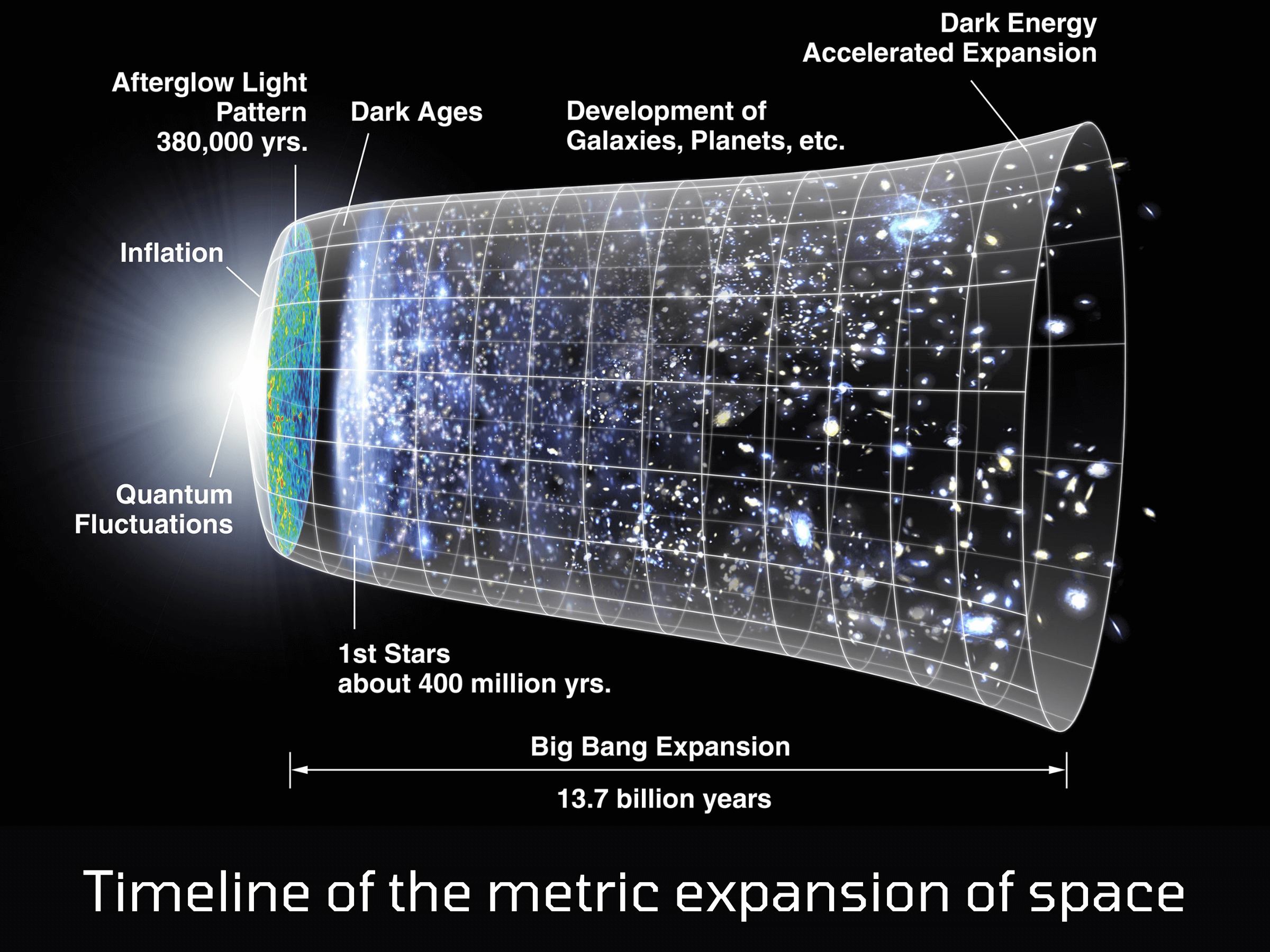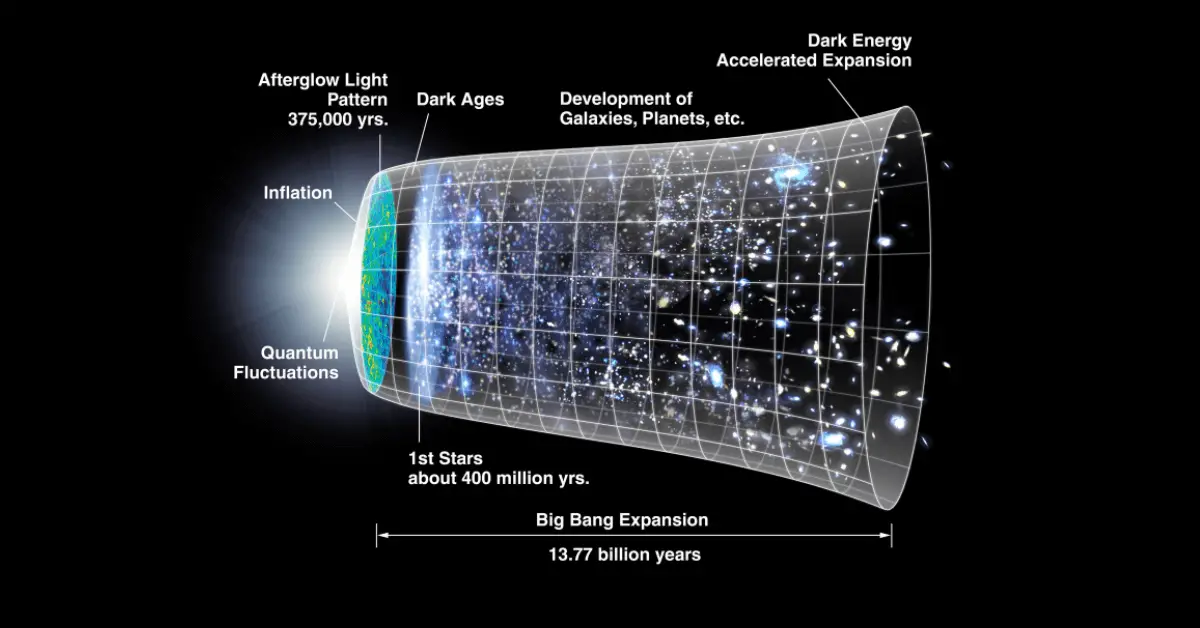- The “cosmological model” of the stretching universe is called the “Big Bang”.
- This theory proves that starting from one single point, the universe spread out and took a proper shape. Georges LemaÎtre proposed this theory.
- Physicists are working to discover the nature of dark energy. This energy caused the universe to further expand.
- The process of Big Bang Nucleosynthesis caused the production of heavier elements like hydrogen & helium.
- It’s been 13.8 billion years since the Big Bang happened but the universe is still expanding.
- But the question arises that will this universe ever stop expanding? Well, the answer is “YES” the universe will stop expanding one day.
What is the Big Bang Theory
The “cosmological model” of the expanding universe is called “Big Bang”. Big Bang Theory explains how the universe began to expand from its initial state of high temperature and density to the millions of planets, and galaxies.
Big Bang Theory Timeline Of Events:
Early Stage:
- In the beginning, everything was packed in a tiny hot ball, full of energy and light. A primordial explosion took place and caused a large-scale evolution.
- Space and time were generated immediately through the process called cataclysm.
- However, the process of “inflation” inducted all the energy and matter which today’s universe holds.
Universe Taking Shape:
- Within a second, the universe’s rapid expansion occurred and at this point, the universe was just the size of a grapefruit.
- Anyway, the universe kept on expanding at a slower rate to come in a proper shape.
The Era Of Radiations:
- Most of the energy was present in the form of radiation just after 3 seconds of explosion. However, dilution of these radiations was occurring due to the expansion of the universe.
- Apart from that, radiation was a good source of glowing microwaves. Eventually, these microwaves started to bathe the whole universe.
- These radiations are known as the wavelength of light, ultraviolet rays, X-rays, and radio waves as well.
- Radiations were detectable from the early formation of the universe after 300,000 years of the Big Bang event.
Formation of Elements:
- Now (100-10,000s), the important elements of hydrogen nuclei like “lithium & helium” are formed.
- During the process of expansion, forces like:
- Gravity.
- Forces holding nuclei of atoms altogether.
- Electromagnetic and weak forces in nature
All of them were appearing as distributed in the environment.
- However, fundamental particles like quarks, photons, electrons, and neutrinos were smashed together to form two important particles called protons & neutrons.
Formation of Galaxies & Stars:
- For the formation of the first protogalaxies and first stars, the matter clumped together under its own gravity.
Formation of Heavier Elements:
- Heavier elements such as carbon, oxygen, silicon, and iron were formed inside stars which were splendid nuclear furnaces.
- Supernovae created even heavier elements because of massive stars’ explosions.
- The trash of such massive stars was present in space as a good source to become future generations of stars and planets.
Dark Energy:
- After a few billion years, the Big Bang expansion of the universe was declarable.
- This expansion further began to accelerate because of an unknown force called “dark energy”. The nature of this dark energy is not explained yet.
Formation of Sun:
- The Sun along with its eight planets and other asteroids, comets, and Kuiper Belt Objects were formed after 9 billion years of the Big Bang.
- They were formed by the trash left by earlier exploded massive stars.
Life On Earth
- After 10 billion years of the Big Bang, finally, the first life appeared on Earth, in the form of a simple cell.
- Now gradually life spreads across the Globe.
Today:
- Today, 13.8 billion years have passed and we are unravelling the mysteries of the universe from our tiny planet, Earth.
- The universe has billions of galaxies, each of which is composed of billions of stars.
- Our planet also owns hundreds of exoplanets, orbiting other stars.
Who Proposed The Big Bang Theory?
- Georges LemaÎtre (1894-1966 ) a Catholic Priest and Belgian Cosmologist, was the first person who appeared with this startling idea, in a scientific form on a paper between 1927-1930.
- He was titled “Father Of Big Bang”.
- Many astronomers accepted this theory given by Georges that says:
“Starting from one point the Universe is continuously expanding. ”
- On the other hand, many astronomers were unable to accept the concept that the universe is created with a bang.

Hubble’s Law On Big Bang Theory:
- After 2 years (1929) of Georges Lemative’s theory on the Big Bang, another astronomer named “Edwin Hubble” came up with a law of that is:
“At a speed that is proportional to their distance, Galaxies are moving apart from Earth.”
Is the Earth Still Moving Apart?
- Hubble’s Theory came up as proof that, “YES”, starting from one single point, the universe is still expanding. As he noticed that the galaxies that were already away from us were continuously moving away, faster than others.
Hubble’s Law As Evidence of the Big Bang:
- The direct observational evidence of the universe could be seen in Hubble’s law which says:
“At a speed that is proportional to their distance, Galaxies are moving apart from Earth”
The relative abundances of light elements and the cosmic microwave background produced by the Big Bang show the given Big Bang theory’s validity.
What is BBN?
- BBN stands for Big Bang Nucleosynthesis which is basically the production of heavier elements like “hydrogen” but mainly it is the production of “helium”.
- Two scientists named “Ralph Alpher & George Gamow (1940)” calculated that:
“This hot and dense universe is able to produce these virtual chemicals called helium, lithium, and deuterium.”
- As the temperature and pressure were so high that they (neutrons & protons) produced traces of lithium, helium, and beryllium with fusion processes.
- This whole process of production is called nucleosynthesis, also known as primordial nucleosynthesis.
Did the Big Bang Happen Simultaneously Everywhere?
- Astronomers say that yes, the cosmos is expanding equally from everywhere and there is no particular edge or centre of the universe. Because if we all run the clock back, then it will be clear to see that 13.8 billion years ago everything was wrapped together on a single point.
- Therefore with this concept, we can figure out that there was no specific place of Big Bang occurring in fact it was happening concurrently everywhere.
Will the Universe Ever Stop Expanding?
- YES, it will stop expanding because in terms of thermodynamics, one day this vast expanding universe will approach its state of maximum entropy & minimum temperature.
- Its ability to get farther and farther apart will cause the material of its dead stars to scatter, which will initially stop the growth of new stars.
- Slowly, galaxies will also stop growing and weird suffocation will be created all over the astrophysical activity.
- The essential fuel for the reproductive system and growth of these galaxies and stars will be diffused and unusable.
- Eventually, the stars will be stripped away so far, and galactic clusters won’t be kept together by gravitational forces.
- The remaining planets and stars will start to explode and there will come a time when the last atoms will also be ripped off.
Basic Misconception related to Big Bang:
- One of the biggest misconceptions about the Big Bang is, most people think that this model will completely explain the “origin of the universe”. But actually, it only describes the emergence of this universe from its initial state. You can not think of comparing the Big Bang with everyday objects.
How Old Is The Universe According To The Big Bang Theory?
All the past and current matter of the universe came into existence roughly around 13.8 billion years ago.
Is this Theory Scientifically Accurate?
“YES”, you will be surprised to know that the Big Bang’s science talk is remarkably accurate. David Saltzberg was the person behind its science. Even the students are so sure about David’s equation that they say: ❛The whiteboard equations can be incorrect but David’s equations could never be proven wrong❜.
Can We Determine The Shape Of The Big Bang?
“Yes,” the astronomers say that we can think of this observable universe to be a sphere-shaped that is extending outwards from the observation point of 46.5 billion light-years.
What Was There Before The Big Bang?
According to Carroll, the universe was an ultra-hot, dense material in a steady state before the Big Bang occurred. He said that this material was directed by extremely small-scale and called it “quantum mechanics”.
How Do We Know The Big Bang Happened?
Traces of the Big Bang such as speeding galaxies to ancient gas clouds tell us a complete story that YES, the Big Bang had happened. Because whatever we know today, started at a moment around 13.8 billion years ago as the Big Bang.
What Started The Big Bang – What Triggered The Big Bang?
Every speck of energy in the universe was jammed on a tiny, dense, single point that exploded with incredible force propelling matter outward to create billions of galaxies. This whole procedure was given the name of “Big Bang”.
What Happened After The Big Bang?
NASA says that the universe kept on expanding at a slower rate. It was full of protons, electrons, anti-electrons, neutrons, and neutrinos after one second of the Big Bang. The universe was dense and hot enough after the explosion but the conditions were under control as the universe cooled for the formation of building blocks of matter, electrons, and quarks.

